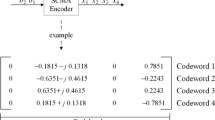Abstract
In a multi-user system, system resources should be allocated to different users. In traditional communication systems, system resources generally include time, frequency, space, and power, so multiple access technologies such as time division multiple access (TDMA), frequency division multiple access (FDMA), space division multiple access (SDMA), code division multiple access (CDMA), and non-orthogonal multiple access (NOMA) are widely used. In semantic communication, which is considered a new paradigm of the next-generation communication system, we extract high-dimensional features from signal sources in a model-based artificial intelligence approach from a semantic perspective and construct a model information space for signal sources and channel features. From the high-dimensional semantic space, we excavate the shared and personalized information of semantic information and propose a novel multiple access technology, named model division multiple access (MDMA), which is based on the resource of the semantic domain. From the perspective of information theory, we prove that MDMA can attain more performance gains than traditional multiple access technologies. Simulation results show that MDMA saves more bandwidth resources than traditional multiple access technologies, and that MDMA has at least a 5-dB advantage over NOMA in the additive white Gaussian noise (AWGN) channel under the low signal-to-noise (SNR) condition.
摘要
在多用户系统中, 系统资源应分配给不同用户. 在传统通信系统中, 系统资源通常包括时间、 频率、 空间和功率, 因此广泛使用诸如时分多址(TDMA)、 频分多址(FDMA)、 空分多址(SDMA)、 码分多址(CDMA)、 非正交多址(NOMA)之类多址技术. 在被认为是下一代通信系统新范式的语义通信中, 我们从语义角度, 以基于模型的人工智能方法, 从信源中提取高维语义域特征, 并针对信源和信道特征联合构建模型信息空间. 从模型信息空间中挖掘语义信息的共性化和个性化信息, 提出一种新的基于语义域资源的多址技术, 称为模分多址(MDMA). 从信息论角度, 证明模分多址比传统多址技术获得更多性能提升. 仿真结果表明, 模分多址比传统多址技术节省更多带宽资源, 并且在低信噪比条件下, 在加性高斯白噪声(AWGN)信道中, 相比非正交多址具有至少5 dB的性能优势.
Similar content being viewed by others
Data availability
The data that support the findings of this study are available from the corresponding authors upon reasonable request.
References
Cover TM, Thomas JA, 2001. Elements of Information Theory. John Wiley & Sons, Ltd., New York, USA, p.374–458. https://doi.org/10.1002/0471200611.ch14
Dai JC, Wang SX, Tan KL, et al., 2022. Nonlinear transform source-channel coding for semantic communications. IEEE J Sel Areas Commun, 40(8):2300–2316. https://doi.org/10.1109/JSAC.2022.3180802
Dai LL, Wang BC, Yuan YF, et al., 2015. Non-orthogonal multiple access for 5G: solutions, challenges, opportunities, and future research trends. IEEE Commun Mag, 53(9):74–81. https://doi.org/10.1109/MCOM.2015.7263349
Ding ZG, Adachi F, Poor HV, 2016. The application of MIMO to non-orthogonal multiple access. IEEE Trans Wirel Commun, 15(1):537–552. https://doi.org/10.1109/TWC.2015.2475746
Dong C, Liang HT, Xu XD, et al., 2023. Semantic communication system based on semantic slice models propagation. IEEE J Sel Areas Commun, 41(1):202–213. https://doi.org/10.1109/JSAC.2022.3221948
Gao S, Zhang M, Cheng X, 2018. Precoded index modulation for multi-input multi-output OFDM. IEEE Trans Wirel Commun, 17(1):17–28. https://doi.org/10.1109/TWC.2017.2760823
Islam SMR, Avazov N, Dobre OA, et al., 2017. Power-domain non-orthogonal multiple access (NOMA) in 5G systems: potentials and challenges. IEEE J Sel Areas Commun, 19(2):721–742. https://doi.org/10.1109/COMST.2016.2621116
Jiang PW, Wen CK, Jin S, et al., 2023. Wireless semantic communications for video conferencing. IEEE J Sel Areas Commun, 41(1):230–244. https://doi.org/10.1109/JSAC.2022.3221968
Krizhevsky A, 2009. Learning Multiple Layers of Features from Tiny Images. Technical Report, TR-2009. University of Toronto, Toronto, Canada.
Kuznetsova A, Rom H, Alldrin N, et al., 2020. The open images dataset V4: unified image classification, object detection, and visual relationship detection at scale. Int J Comput Vis, 128:1956–1981. https://doi.org/10.1007/s11263-020-01316-z
Li WZ, Liang HT, Dong C, et al., 2023. Non-orthogonal multiple access enhanced multi-user semantic communication. https://arxiv.org/abs/2303.06597
Luo XW, Gao RB, Chen HH, et al., 2022. Multi-modal and multi-user semantic communications for channel-level information fusion. IEEE Wirel Commun, early access. https://doi.org/10.1109/MWC.011.2200288
Mao Y, Dizdar O, Clerckx B, et al., 2022. Rate-splitting multiple access: fundamentals, survey, and future research trends. IEEE Commun Surv Tutor, 24(4):2073–2126. https://doi.org/10.1109/COMST.2022.3191937
Saito Y, Kishiyama Y, Benjebbour A, et al., 2013. Nonorthogonal multiple access (NOMA) for cellular future radio access. IEEE 77th Vehicular Technology Conf, p.1–5. https://doi.org/10.1109/VTCSpring.2013.6692652
Shannon CE, 1948. A mathematical theory of communication. Bell Syst Tech J, 27(3):379–423. https://doi.org/10.1002/j.1538-7305.1948.tb01338.x
Shi YX, Shao S, Wu YP, et al., 2023. Excess distortion exponent analysis for semantic-aware MIMO communication systems. https://arxiv.org/abs/2301.04357
Wang SX, Dai JC, Liang ZJ, et al., 2023. Wireless deep video semantic transmission. IEEE J Sel Areas Commun, 41(1):214–229. https://doi.org/10.1109/JSAC.2022.3221977
Wang Z, Zhang JY, Du HY, et al., 2023. Extremely large-scale MIMO: fundamentals, challenges, solutions, and future directions. IEEE Wirel Commun, early access. https://doi.org/10.1109/MWC.132.2200443
Weng Z, Qin Z, 2021. Semantic communication systems for speech transmission. IEEE J Sel Areas Commun, 39(8):2434–2444. https://doi.org/10.1109/JSAC.2021.3087240
Wu Z, Lu K, Jiang C, et al., 2018. Comprehensive study and comparison on 5G NOMA schemes. IEEE Access, 6:18511–18519. https://doi.org/10.1109/ACCESS.2018.2817221
Xie H, Qin Z, Li GY, et al., 2021. Deep learning enabled semantic communication systems. IEEE Trans Signal Process, 69:2663–2675. https://doi.org/10.1109/TSP.2021.3071210
Zhang P, Xu WJ, Gao H, et al., 2022a. Toward wisdom-evolutionary and primitive-concise 6G: a new paradigm of semantic communication networks. Engineering, 8:60–73. https://doi.org/10.1016/j.eng.2021.11.003
Zhang P, Peng MG, Cui SG, et al., 2022b. Theory and techniques for “intellicise” wireless networks. Front Inform Technol Electron Eng, 23(1):1–4. https://doi.org/10.1631/FITEE.2210000
Zhang P, Xu XD, Dong C, et al., 2022c. Intellicise communication system: model-driven semantic communications. J China Univ Posts Telecommun, 29(1):2–12. https://doi.org/10.19682/j.cnki.1005-8885.2022.2002
Zhang Y, Xu W, Gao H, et al., 2022. Multi-user semantic communications for cooperative object identification. IEEE Int Conf on Communications Workshops, p.157–162. https://doi.org/10.1109/ICCWorkshops53468.2022.9814491
Zhu YW, Huang YK, Qiao XQ, et al., 2022. A semantic-aware transmission with adaptive control scheme for volumetric video service. IEEE Trans Multim, early access. https://doi.org/10.1109/TMM.2022.3217928
Author information
Authors and Affiliations
Contributions
Ping ZHANG, Xiaodong XU, Chen DONG, and Kai NIU proposed the main idea. All the authors designed the research. Ping ZHANG, Xiaodong XU, Chen DONG, Kai NIU, Haotai LIANG, and Zijian LIANG participated in theoretical analysis and simulation verification, and drafted the paper. All the authors revised and finalized the paper.
Corresponding authors
Ethics declarations
Ping ZHANG, Xiaodong XU, Chen DONG, Kai NIU, Haotai LIANG, Zijian LIANG, Xiaoqi QIN, Mengying SUN, Hao CHEN, Nan MA, Wenjun XU, Guangyu WANG, and Xiaofeng TAO declare that they have no conflict of interest.
Additional information
Project supported by the National Key R&D Program of China (No. 2022YFB2902102)
Rights and permissions
About this article
Cite this article
Zhang, P., Xu, X., Dong, C. et al. Model division multiple access for semantic communications. Front Inform Technol Electron Eng 24, 801–812 (2023). https://doi.org/10.1631/FITEE.2300196
Received:
Accepted:
Published:
Issue Date:
DOI: https://doi.org/10.1631/FITEE.2300196




